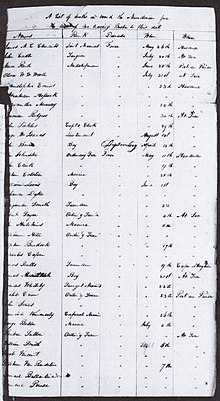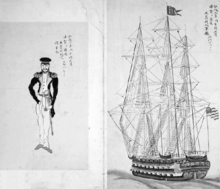| This article needs additional citations for verification. Please help improve this article by adding citations to reliable sources. Unsourced material may be challenged and removed. Find sources: "James Biddle" – news · newspapers · books · scholar · JSTOR (December 2017) (Learn how and when to remove this message) |
| James Biddle | |
|---|---|
 portrait by Thomas Sully, 1839 portrait by Thomas Sully, 1839 | |
| Born | February 18, 1783 |
| Died | October 1, 1848 |
| Alma mater | |
| Parent(s) | |
| Family | Nicholas Biddle, Thomas Biddle, John Biddle, Richard Biddle |
| Signature | |
| Branch | United States Navy |
James Biddle (February 18, 1783 – October 1, 1848), of the Biddle family, brother of financier Nicholas Biddle and nephew of Capt. Nicholas Biddle, was an American commodore. His flagship was USS Columbus.
Education and early career
Biddle was born in Philadelphia, where he attended the University of Pennsylvania. After graduating, he entered service in the United States Navy as a midshipman in 1800.
Retained in the navy reduction of 1801, Biddle served in the war against the Barbary pirates. Early in 1802, Biddle joined the Constellation, under Captain Alexander Murray and was part of his fleet in the Mediterranean.
The ship he was in, USS Philadelphia, struck rocks off Tripoli, and along with his commodore, William Bainbridge, he was kept imprisoned for 19 months. In 1805, Bainbridge acknowledged his progress up the ranks would be swift from midshipman to lieutenant, which was granted in 1807. He would be promoted to command his own ship on March 5, 1813.
During the War of 1812, Biddle was first lieutenant in the USS Wasp. He was in command of the sloop USS Hornet in 1815 when she defeated HMS Penguin. In 1817, he was sent to the Columbia River in the USS Ontario to formally take over the Oregon Country for the United States, which was completed in 1818. His diplomatic duties with Chile and the commander of the San Marin fleet, Lord Thomas Cochrane, allowed the U.S. to occupy the territory.
After the war, Biddle performed various duties in the Gulf of Mexico, the South Atlantic, and the Mediterranean. His In 1830, Biddle and US Consul David Offley negotiated and concluded a treaty with the Sublime Porte. The treaty was later used by U.S. diplomats to claim extraterritorial privileges for U.S. citizens in the Ottoman Empire.
Biddle and the USS Macedonian
In the early nineteenth century, the prevalence of yellow fever in the Caribbean "led to serious health problems" and alarmed the United States Navy as numerous deaths and sickness curtailed naval operations and destroyed morale. A tragic example occurred in May 1822 when the frigate USS Macedonian left Boston and became part of Commodore James Biddle's West Indies Squadron. Secretary of the Navy Smith Thompson had assigned the squadron to guard United States merchant shipping and suppress piracy. Biddle was also involved in a plan to promote Cuban independence from Spain and annexation to the United States. During their deployment seventy six of the Macedonian officers and men died. Seventy four of these deaths were attributed to yellow fever. Biddle reported another fifty two of his crew were on sick-list. The magisterial work by David Mc Culloch The Path Between the Seas: The Creation of the Panama Canal, 1870-1912, gives a memorable account of the devastation. In his report to the Secretary of the Navy, Biddle and Surgeon's Mate Dr. Charles Chase state the cause as "fever". As a consequence of this loss, Biddle noted his squadron was forced to return to Norfolk Navy Yard early. The Macedonian crew upon arrival were provided medical care and quarantined at Craney Island. Biddle upset at the loss of his crew wrote Smith Thompson " how deeply my feelings have been afflicted at the disturbing mortality & sickness and …. I hope you will order an investigation into the cause of the sickness on board."
Biddle told Thompson the Macedonian had been improperly fitted out in Boston and while there, the frigate's hold was never properly cleaned and that the filth and debris he discovered in the hold had led to the fever. Biddle consequently brought charges against Commodore Isaac Hull then in command at the Boston Naval Yard. Medical testimony during a court of inquiry however supported the conclusion that a drastic change in temperatures, dampness, and tropical climate were the proximate cause of the fever, and "Much to Biddle's chagrin the court of inquiry found Hull not guilty."

Expeditions to Asia



In December 1845, Biddle exchanged ratifications of the Treaty of Wanghia

On July 20, 1846, he anchored with the two warships USS Columbus and USS Vincennes in Uraga Channel at the mouth to Edo Bay in an attempt to open up Japan to trade with the United States, but was ultimately unsuccessful. Biddle delivered his request that Japan agree to a similar treaty to that which had just been negotiated with China. A few days later a Japanese junk approached Biddle's flagship, and requested his presence on board their ship to receive the Tokugawa shogunate's official response. Biddle was reluctant at first, but eventually agreed. As Biddle attempted to board the Japanese ship, he misunderstood the instructions of one of the samurai guards and was physically knocked back by the guard who then drew his sword. Biddle retreated to his flagship. The Japanese officials apologized for the mishap. Biddle eventually received the shogunate's response, and was told that Japan forbade all commerce and communication with foreign nations besides that of the Dutch; also, he was informed that all foreign affairs were conducted through Nagasaki, and that his ships should leave Uraga immediately.
Seven years later, Commodore Matthew Perry did the task with four warships. Perry was well aware of Biddle's reception, and strove to make sure that he would not be treated in the same manner.
Biddle died in Philadelphia, and is buried at Christ Church Burial Ground in the family plot.
See also
References
- Sewall, John S. (1905). The Logbook of the Captain's Clerk: Adventures in the China Seas, p. xxxi.
- ^ Van Zandt, Howard (1984). Pioneer American Merchants in Japan. Tuttle Publishing. p. 13. ISBN 9994648144.
- Sewall, pp. xxxiv-xxxv, xlix, lvi.
- Sewall, pp. 167-95, 243-64.
Further reading
- Long, David F. Long. (1983). Sailor-Diplomat: A Biography of Commodore James Biddle, 1783-1848 Boston: Northeastern University Press. ISBN 978-0-930350-39-0
- Sakamaki Shunzo. Japan and the United States, 1790-1853. Wilmington: Scholarly Resources, 1973.
- Sewall, John S. (1905). The Logbook of the Captain's Clerk: Adventures in the China Seas, Bangor, Maine: Chas H. Glass & Co. ISBN 0-548-20912-X
External links
![]() Media related to James Biddle at Wikimedia Commons
Media related to James Biddle at Wikimedia Commons
- Documents relating to Biddle's mission to Oregon
- T. C. Elliott, "An Event of One Hundred Years Ago" in Oregon Historical Quarterly vol. 19 (1918).
| Military offices | ||
|---|---|---|
| Preceded byFoxhall A. Parker, Sr. | Commander, East India Squadron 21 April 1845–6 March 1848 |
Succeeded byWilliam Shubrick |
- 1783 births
- 1848 deaths
- United States Navy officers
- Biddle family
- Congressional Gold Medal recipients
- Oregon Country
- Members of the Philadelphia Club
- Military personnel from Philadelphia
- University of Pennsylvania alumni
- American people of the Barbary Wars
- Burials at Christ Church, Philadelphia
- People from Pennsylvania in the War of 1812